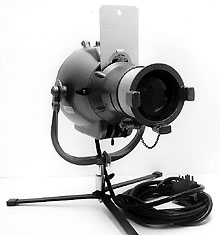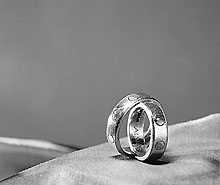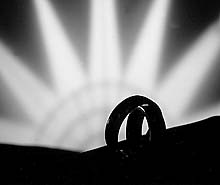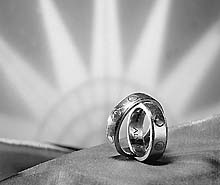DHA's Metal Gobos
The only entry that the average photographic book's index lists under
Go... is Goerz - designer of early anastigmatic wide-angle lenses, one of
which, the Hypergon, employed a rotating star-shaped device to help combat
non-uniform illumination. Interesting though this is, the average index
lacks any mention of the word Gobo. It therefore seems sensible to start
by defining a gobo: a mask that is fitted into a light which capable of
projecting a well defined image. Shaped slide mounts are gobos of a sort.
More commonly, gobos shape only light itself (not any image carried by the
light) and are used to create interesting shadow patterns, especially on
backgrounds. The essential property of a gobo is therefore its ability to
cast a shadow in some areas and to leave other parts of the beam
untouched. Gobos used in the ImageMaker (reviewed last month) are made of
plastic: other types are made of metal.
 A gobo is useless without the right light. Important features are a small
light source and an optical focusing system that will account for
different throws (light-to-screen distances). In lighting terms, the best
choice is a dedicated Profile Spot. In practical terms, it is common to
fit a focusing accessory onto the front of a standard light and to use
this as a gobo projector. Often, a zoom action is provided. This is not
really needed in most photographic uses, having originated in theatre
applications where the light is operated from a fixed position but may
have to provide different areas of coverage. In studios, it is the norm
for lights to be moved around as required.
A gobo is useless without the right light. Important features are a small
light source and an optical focusing system that will account for
different throws (light-to-screen distances). In lighting terms, the best
choice is a dedicated Profile Spot. In practical terms, it is common to
fit a focusing accessory onto the front of a standard light and to use
this as a gobo projector. Often, a zoom action is provided. This is not
really needed in most photographic uses, having originated in theatre
applications where the light is operated from a fixed position but may
have to provide different areas of coverage. In studios, it is the norm
for lights to be moved around as required.
Different lights take different size gobos. In the case of the
ImageMaker, gobos are provided by the manufacturer, but in general they
are obtained from independent sources. In the UK, the foremost of these is
DHA Lighting, which supplies both photographic and theatre users and
offers gobos in a wide range of sizes. Astute readers may recall that the
company had a stand at Focus On Imaging earlier this year (as it has for
the previous two years too).
DHA supports all the common photographic lights, including Bowens,
Broncolor, Elinchrom and Multiblitz, as well as a host of tungsten units
(including Photon Beard and Hedler). In addition, most other lights (such
as the author's aged Courtenay Nova Twin Spot shown here) can be fitted
with one of DHA's nine standard gobo sizes. Prices depend on the size
chosen, but are most are around �6 each. Durability is excellent: the
author has never yet suffered a broken DHA gobo in almost eight years of
using them. Holders are also available, and can be made to suit special
sizes if required. In some cases, it may prove cheaper to obtain a
custom-made holder for stock-size gobos than to persevere with more
expensive non-standard items. In all, DHA offers more than 700 designs,
ranging from abstract patterns to specific items with recognisable scenes
or words. As well as leaves, reflected water patterns and city skylines,
there are pumpkins for Halloween pictures, holly and fir trees for
Christmas, and a bunny with the words Happy Easter for, well, Easter!
Custom designs can also be made if required. A free information pack,
which includes a vast number of gobo diagrams, is available on request
from DHA (tel: 0171 771 2900).
Lighting control is very much more critical when using gobos than at any
other time. Under normal circumstances, small amounts of spill from one
light into the illumination area of another has very little effect on the
overall quality. Not so when gobos are used. Gobos are effective only when
there are areas of darkness that can be selectively lit to reveal the
projected pattern. Spill makes dark areas grey, reducing contrast and
making the shadow pattern less clear.
There are three easy ways of helping to ensure optimum quality when gobos
are used for projecting onto backgrounds.
1) Avoid poorly controlled broad lighting techniques. If softboxes are
used, ensure that barndoors or grids are fitted to prevent spill.
2) Avoid placing general fill-in lights on, or close to, the lens axis.
3) Try to have as much separation as possible between the subject and the
background. If subject lighting still reaches the background, use a darker
background colour and boost the brightness of the gobo light.
Things are slightly different if the gobo is casting a shadow on the
foreground (providing a dappled effect, for example). Here, contrast is
usually lower, so spill is less of a problem (and may even be desirable).
Conversely, there is no control over the 'screen' colour or brightness, so
there is less room to vary the appearance of the shadow pattern.
As far as 'screens' go, shadow patterns can be projected onto paper
background rolls (of any colour), walls, wallpapered flats, tables, or
even naked bodies. For most uses, a flash head of 500J will perform
adequately. If black paper backgrounds are used, more power will be
required but better contrast will result. In the image shown here, for
example, the gobo was projected onto white card using 300J of light,
giving a modest low-contrast result.
A useful trick to determine lighting purity when using gobos is to check
the effect of each light individually. Extracts from a b&w contact print
show this for the example image. One frame shows the foreground lighting
alone, another shows the gobo light alone, and the third shows the
combined effect.


 The image top right shows the original shot
The image top right shows the original shot
The gobo used here was a compass pattern (DHA 439), dropped below the
horizon to give a sunrise effect. It was projected using the Courtenay
Nova Twin head shown. The pack was set to 300J and a yellow/orange filter
was fitted in front of the light. Foreground illumination came from two
Jessop 336VM heads, one (overhead) fitted with a softbox and the other
(from rear left) fitted with a snoot into the front of which was placed a
small lens. The final image was shot on Kodak Ektachrome 100SW film
(pushed one stop in processing) at an aperture of F22.5 using a 90mm lens
and extension tubes on a Mamiya RB67. The background card was about 40cm
behind the rings, which are recorded just slightly less than life size on
the finished transparency.
Return to Photon August 96 contents
 A gobo is useless without the right light. Important features are a small
light source and an optical focusing system that will account for
different throws (light-to-screen distances). In lighting terms, the best
choice is a dedicated Profile Spot. In practical terms, it is common to
fit a focusing accessory onto the front of a standard light and to use
this as a gobo projector. Often, a zoom action is provided. This is not
really needed in most photographic uses, having originated in theatre
applications where the light is operated from a fixed position but may
have to provide different areas of coverage. In studios, it is the norm
for lights to be moved around as required.
A gobo is useless without the right light. Important features are a small
light source and an optical focusing system that will account for
different throws (light-to-screen distances). In lighting terms, the best
choice is a dedicated Profile Spot. In practical terms, it is common to
fit a focusing accessory onto the front of a standard light and to use
this as a gobo projector. Often, a zoom action is provided. This is not
really needed in most photographic uses, having originated in theatre
applications where the light is operated from a fixed position but may
have to provide different areas of coverage. In studios, it is the norm
for lights to be moved around as required.

